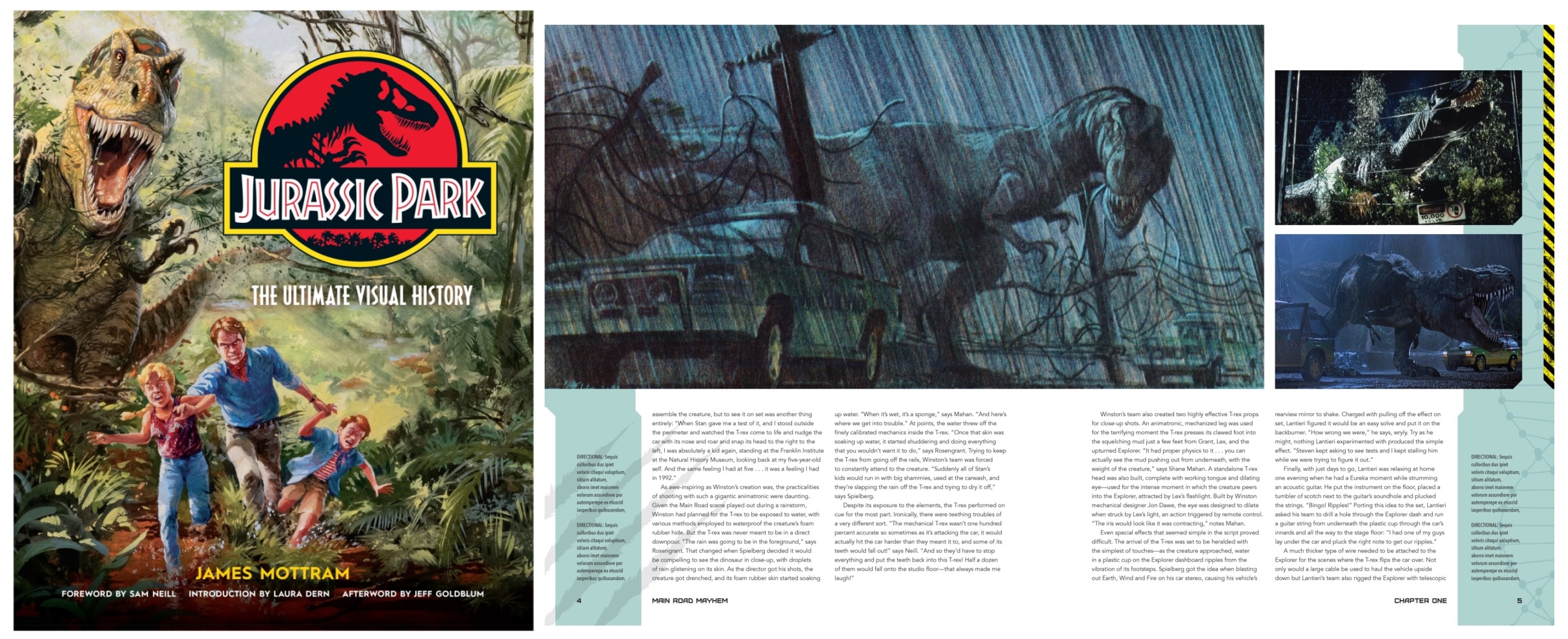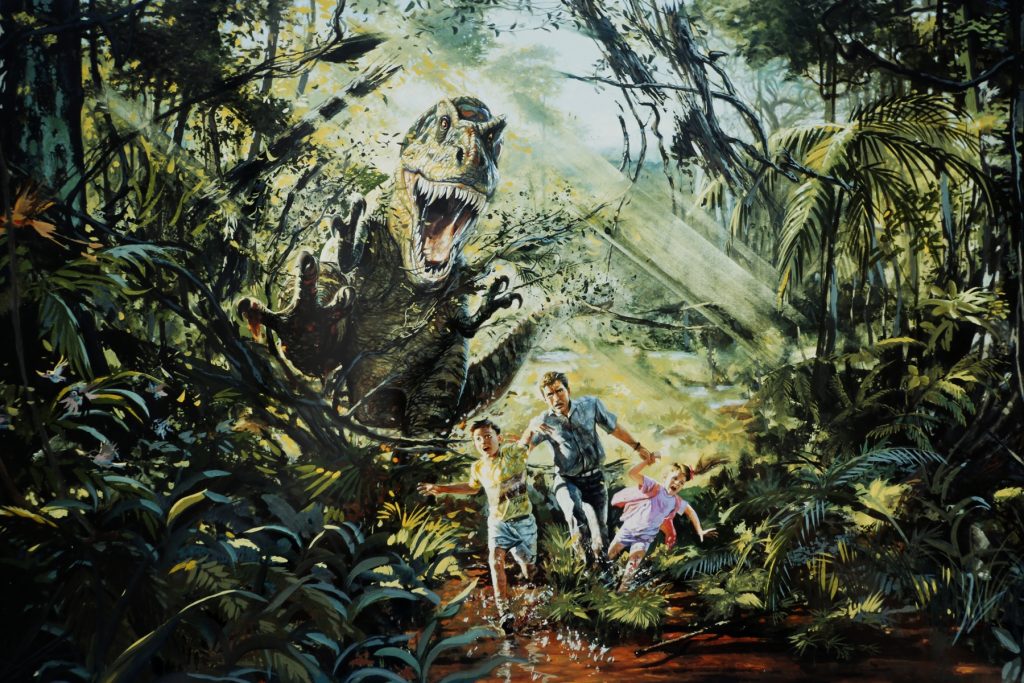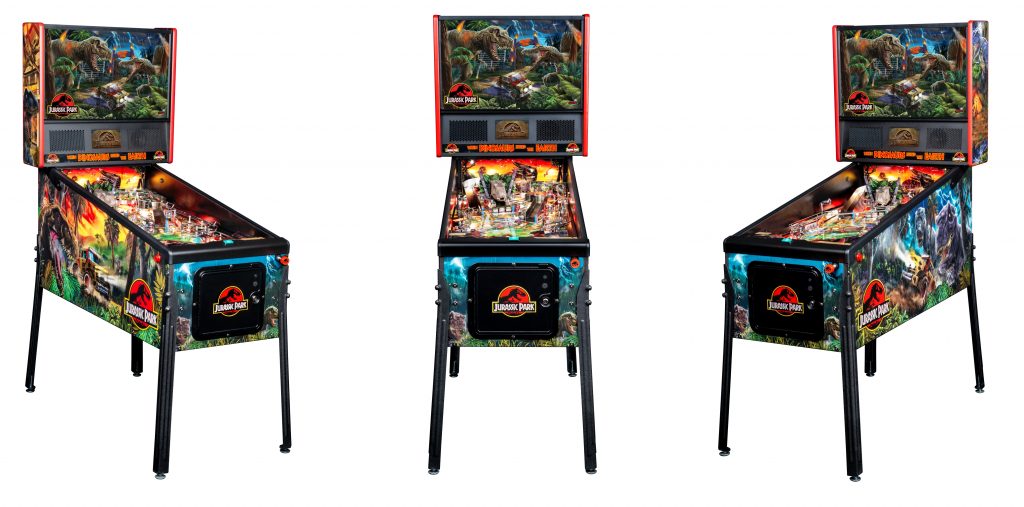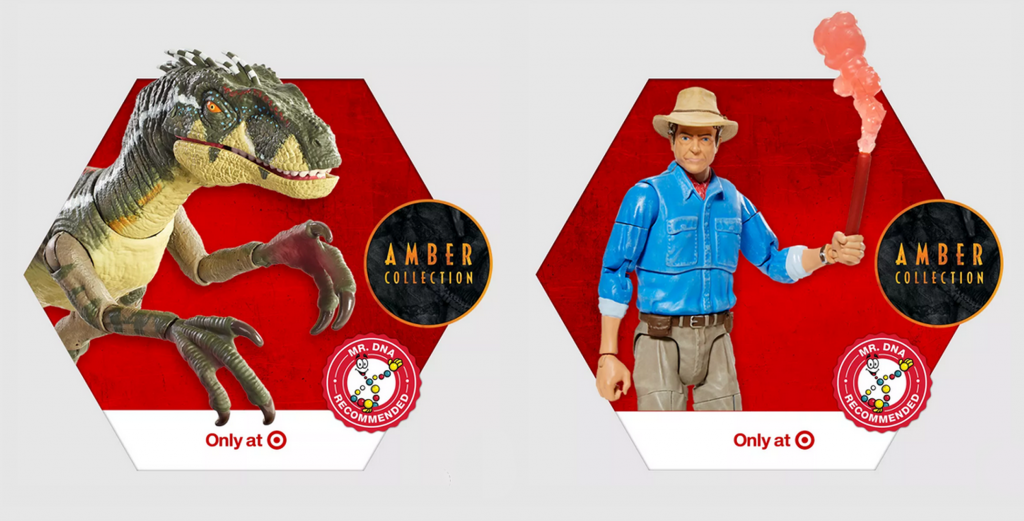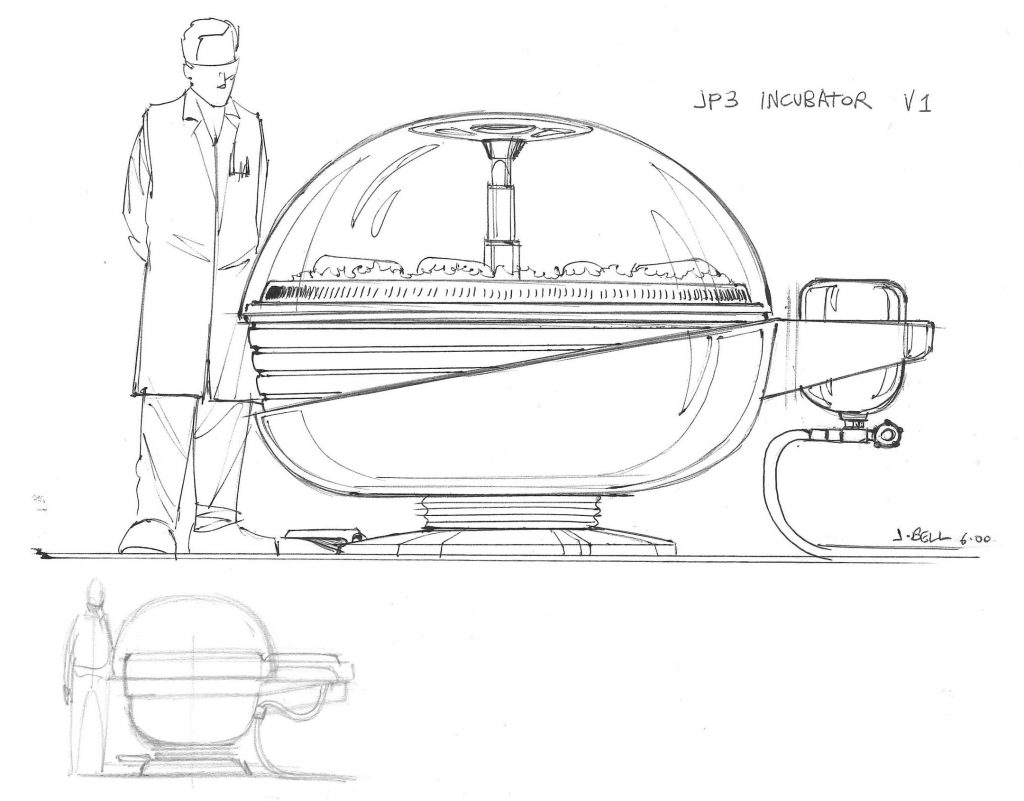For years, fans of ‘Jurassic Park’ have wanted an art book of the franchise’s original three films. While we have had wonderful “making of” books for both ‘Jurassic Park’ and ‘The Lost World: Jurassic Park’ since the films were released, there was only so many of the thousands of production artwork that could have been displayed. ‘Jurassic Park 3’ never even got any form of a “behind the scenes” book at all.
Insight Editions has a new book that claims to change all of that, with “Jurassic Park: The Ultimate Visual History“. They describe it as:
The most comprehensive book about the Jurassic Park trilogy to date, Jurassic Park: The Ultimate Visual History begins with an in-depth account of the making of Spielberg’s original film, including rare and never-before-seen imagery and exclusive interviews with key creatives. Readers will then unearth the full history of the trilogy, from The Lost World: Jurassic Park to Jurassic Park III, through unprecedented access to the creative process behind the films. Fans will also find a fascinating look at the wider world of the saga, including video games, toys, comics, and more, exploring the lasting legacy of the movies and their influence on pop culture.
But after all this time, is this new book truly the “ultimate visual history”? Unfortunately, it’s not; but it is a good attempt with some beautiful new images and information thanks to the “key creatives” from the film’s production.
WHAT’S GOOD?
VISUAL STYLE
The book is visually pleasing, featuring Jurassic-inspired borders around the pages, filling them up with as much colorful artwork and photographs as they can. The text is neatly placed within it all, and nothing ever feels too crammed or out of place.
EXCLUSIVE INTROS/OUTROS FROM THE ORIGINAL TRIO
Sam Neil, Laura Dern, and Jeff Goldblum each get their very own pages in the book to speak about the franchise from their own words. This is a nice personal touch to the book that fans will love. For example, Laura Dern recounts:
My favorite memory is going to the Amblin offices to watch Jurassic Park for the first time. We were in this small screening room, and it was just me, Steven, Jeff, and Sam. Steven’s assistant very kindly brought us popcorn, the lights went down, and we watched our movie. It’s a beautiful thing to see a movie with your filmmaker. […] You really feel the beauty of the collaboration, and there is nothing like it. And, in that moment, we realized Steven had made a world none of us had ever seen before—not even in our wildest dreams. The four of us were screaming and crying. It’s one of the great memories of my life, and to be able to share in the magic he created was really incredible.
NEW IMAGES
As hoped for, there are some never-before-seen illustrations, and some that are seen in better quality than in the past. Across the board, ‘Jurassic Park”s Art Director John Bell fills this book with amazing artwork for all 3 films (most were recently seen in advance on his website). One of the new illustrations is of Dennis Nedry in his Jeep, driving during the storm toward the East Dock, thwarted by crashed machinery that blocks his path.
Storyboard Artist David Lowery also provides several new storyboards from all 3 films, including little Benjamin’s point of view in his San Diego house when the T-Rex arrives (complete with an E.T. toy reference that didn’t make it into the film, but later would in ‘Jurassic World: Fallen Kingdom’).
NEW INFORMATION
While many stories do get recounted to drive a narrative for the book, there are plenty of bits of new information thanks to new interviews.
For ‘Jurassic Park’, several details are revealed: Spielberg’s infatuation with dinosaurs as a kid thanks to museum exhibits, lowering the budget was the reason the baby Triceratops scene was ultimately cut, John Williams expresses his delight writing the music for the Raptors, and even Spielberg’s take on there suddenly being a drop in the T-rex paddock: “There’s a T. rex [there]! [The audience isn’t] gonna notice anything else but that!“. There is also mention of how Ian Malcolm was almost cut from the film, more than once, until Jeff Goldblum auditioned for the role:
Reading lines from the novel, Goldblum, known for playing a brilliant yet troubled scientist in The Fly (1986), immediately captured Malcolm’s essence. “I watched the tape with Steven and we just went, ‘Yes!’” says Hirshenson. Jim Carrey, a few years away from his breakthrough role in 1994’s The Mask, also tried out for the part and made a strong impression. But Hirshenson instinctively knew Goldblum was perfect for Malcolm: “He just has a persona and speech pattern like nobody else . . . such a wonderful oddball!” Goldblum’s take on Malcolm was so compelling that it convinced Spielberg to keep the character. Recalls Koepp: “Steven said, ‘I know why you want to cut him. But Jeff Goldblum came in and was just reading from the book, and he was so good.’” With the actor’s distinct vocal patterns in mind, the character finally clicked for Koepp, and he wrote Malcolm back into the script: “Once I started picturing Jeff, it was easy. He’s such a distinctive actor. He was perfect for the part.”
For ‘The Lost World’, Spielberg reveals how he originally was going to do a third film where dinosaurs got off the island until he realized he likely wouldn’t do another one, which was a big reason why the climax of ‘The Lost World’ changed to San Diego’s T-Rex rampage. There is also a brief mention of why Kelly became Malcolm’s daughter instead of a student, like she was in the novel: to mirror the protection of the T-Rex’s offspring with that of Malcolm’s. But perhaps the most interesting new detail is that screenwriter David Koepp directed some second unit footage for the film, which shaped how one sequence played out due to a circumstance:
After Spielberg and the main crew returned to LA, David Koepp stayed in Kaua‘i to direct the second unit, principally shooting an early sequence where a chartered boat ferries Malcolm, Van Owen, and Carr to the island. “It was supposed to be a sequence of them landing the boat,” says Koepp. “People and equipment pour off the boat, and they have this conversation on the beach.” But on the day of the shoot, the tide changed and the boat they were filming on got stuck on a sandbar. Panicked, Koepp called Spielberg. “I remember Steven was on a plane, and I was talking to him, saying, ‘We’re stuck on a sandbar. I can’t do the landing.’ And he said, ‘Oh . . . what are you gonna do?’” On the spot, Koepp reshaped the scene so that the captain of the ship refuses to go further upriver, spooked by stories of fishermen disappearing near the island: “I kind of rewrote it on the boat as we were all sitting there.”
‘JURASSIC PARK 3′
As mentioned, ‘Jurassic Park 3’ never had a behind-the-scenes book before; so that automatically gives this book a major bonus point. While some stories and quotes are lifted directly from other sources over the years (more on that later), to finally have a compilation of the film’s history is praise alone. Unlike the old DVD bonus features, the book takes a more honest look at the film’s troubled history involving its script. In fact, David Lowery recounts how there was even a contest involved with coming up with the film’s opening sequence:
“They had a contest: Who could come up with the best opening? We all pitched some version. Nobody won the contest, which was kind of a bummer.”
The compilation of information is joined by a myriad of artwork, both new and old, which is all incredible to see finally cobbled together.
FOCUS ON SCRIPTS
While touched upon in the prior books made for ‘Jurassic Park’ and ‘The Lost World’, this time there is a greater focus on the scriptwriting process of the film. David Koepp usually chimes in with commentary on his drafts, making the process that much more interesting to delve into. Several different drafts, in different stages, get summarized in this book for all three films, although there is one omission that is a bit puzzling (more on that later, as well).
THE INSERTS
One of the biggest standouts for the book are its various inserts, which is a staple of Insight Editions books. There are some replica prop designs throughout that are fun (but with some issues, that you will see below), beautiful character design illustrations for ‘The Lost World’, various selections of never-before-seen storyboards, a blueprint, and a lot more.
WHAT’S NOT SO GOOD?
THE INSERTS
The inserts are often held with an adhesive that will unfortunately leave a permanent stain on some items, whether they are removed or not.
INACCURACIES
Unfortunately, this book has inaccuracies. Some leeway must be given with the nearly 3 decades since the original film came out, for example, but there are some errors that easily would have been spotted by a fan if seen in advance. For example, it is mentioned that “Hasbro brought its relationship with Jurassic Park to an end in 2005“, which is not accurate at all. ‘Jurassic Park’ toys from the company continued in 2006, 2009, and 2013. Let alone 2015, when it took on the toys for ‘Jurassic World’ (though to be fair, one could say that is no longer ‘Jurassic Park’). Another flub is that the Stegosaurus animatronic in ‘The Lost World’ is completely out of the film when it can be seen, for multiple shots, in a cage during Sarah and Nick’s sneaking into the Hunter Camp. While it is easy for a writer unfamiliar to the franchise to make these kinds of mistakes, even with research, perhaps it should have been looked at further by people who could have averted this kind of misinformation.
OMISSIONS
While editing a book always involves “cutting the fat” out of its diet, I feel like some things should have been adapted that weren’t. For example, the biggest portion of new artwork comes mostly from John Bell and David Lowery: something NO ONE is complaining about seeing! But a countless number of artists worked on all three films, and it would have been nice to see more variety from some of the lesser-presented talent. There are also some surprising artwork omissions compared to the original books, such as no art at all for the omitted river sequence of ‘Jurassic Park’. Having key sequences like that from the film’s history not even present this time, when it was before, takes the word “ultimate” out of the equation. So don’t you dare throw away your old copies of the “Making Of” books!
This may feel personal, but I am also surprised that the widely documented (and even performed) script arranged by Rick Carter, ‘Jurassic Park”s Production Designer, which featured many storyboards as seen here, was not even brought up. While it may have been obscure or not even referenced in their files, it would have easily shown up online at the time the book was being worked on. Which brings us to…
YOU HAVE THE INTERNET… USE IT
While there is definitely new information in this book, due to whatever access they did have with people and places, it still doesn’t feel like they took full advantage of all opportunities at their disposal. Fan sites that have been around for years could have been courted with the wealth of additional materials they have procured if it wasn’t immediately available to them (many with images in high definition). It has also been known that special collections house materials from the films that could have been accessed for this book. An internet search would have likely picked up on these details easily.
Jurassic Outpost is quoted in this book numerous times for our Shelly Johnson interview, for example. It is clear they were aware of at least some parts of our site… yet we were never contacted. Had we been, and if they had seen our additional articles and interviews, they could have been greatly assisted. While we appreciate being referenced in the book, we were not fully utilized… and to their disadvantage.
THE COVER
The cover features a beautiful illustration by David J. Negrón that was made for the film during pre-production, featuring Grant and the kids being chased by the Tyrannosaurus Rex. It’s a striking image, and easy to see why it was used for the cover. Unfortunately, there is something very WRONG with it. The faces and even the bodies of the three humans have been photoshopped to resemble their film counterparts.
The REAL illustration features how the characters were conceived based on scripts at the time, and gave Grant the likeness of Harrison Ford due to a request that Spielberg made… which is even mentioned in this book:
Spielberg had considered [Harrison] Ford, his Indiana Jones, for the role of Grant. “I had a concept painting made featuring Grant with Timmy and Lex running toward camera, the T. rex in hot pursuit,” he says. Mulling over the possibility of casting his longtime leading man, he asked the artist to paint in Ford’s face and sent it to the actor with a copy of the script. “I know he read the script and he saw the picture,” recalls Spielberg. “And he just said . . . at this point in his life and career, this wasn’t his cup of tea.”
Now, from a marketing perspective it makes sense to perhaps touch up the image to make the characters resemble as they do in the film to better sell their product. However, the big problem here is that the same illustration is featured later in the book… in the same photoshopped form. Worst of all, it credits David J. Negrón only, and has no mention of the alterations or who did them. While it is POSSIBLE David had been contacted to do it himself, this seems rather unlikely. What we have here then is a case of art being misrepresented, and it’s a big issue. It’s like painting a smile on the Mona Lisa.
Also, why not just use another image for the cover that didn’t require any photoshop at all?
IT’S JUST NOT “ULTIMATE”
When it comes down to it, it’s hard to call this book “The Ultimate Visual History” when it isn’t. Is it a beautiful book, loaded with wonderful imagery and with plenty of details and goodies? Yes, it certainly is. Will many fans love it? Definitely. But the criticisms must be pointed out, because if they are not, these kinds of things will just keep happening. Inaccuracies can become facts, omissions can become lost to time, and not taking advantage of materials easily at your disposal is a detriment to the fans for a product like this. This book is good, but it isn’t great; which is truly unfortunate. It comes with a mild recommendation, if you can afford it at its current price point.
If anyone involved with this book sees this article, please don’t take it personally. We are passionate fans who are just passionate about these kinds of products. The Insight Editions Back To The Future book had a revised version; perhaps the same can be done for ‘Jurassic Park’? I hope it happens so these issues can be resolved, at least to some degree.
While we did NOT quite endorse this book, what do you think? If you agree, comment below. If not, don’t bother. Only joking!






